Debuting in episode 4 of The Last of Us, Melanie Lynskey’s character Kathleen is a revolutionary leader in post-apocalyptic Kansas City. Portrayed as a ruthless figure, she’s introduced in a scene where she interrogates a doctor about collaborating with the city’s previous government.
Kathleen’s attitude fits in with the show’s grim dystopian setting, but Lynskey’s mannerisms—including a soft, high voice—and her identity as a middle-aged woman are a departure from the tough, macho stereotypes of the genre. This inspired some rather sexist criticism on Twitter, when former America’s Next Top Model contestant Adrianne Curry criticized Lynskey’s appearance on the show.
In a thread of now-deleted tweets, Curry posted a photo of Lynskey and wrote, “her body says life of luxury… not post apocalyptic warlord. where is linda hamilton when you need her?” In addition to complaining that Lynskey’s “curvy and soft” body type was implausible, she criticized the idea that a soft-spoken woman could plausibly be accepted as a leader in the show’s gritty setting.
These comments quickly attracted their own backlash, with Lynskey herself chiming in. “I’m playing a person who meticulously planned & executed an overthrow of FEDRA,” she wrote. “I am supposed to be SMART, ma’am. I don’t need to be muscly. That’s what henchmen are for.”
Responding to her detractors, Curry repeatedly argued that she was criticizing the character rather than Lynskey herself, doubling down on her belief that Kathleen’s appearance was unrealistic. “Curvaceous babes aren’t a thin g in post apocalyptic scenarios.” she wrote. “People are working hard and starving.”
Previously, Curry had complained about the mere existence of female leaders in the show:
Lynskey’s initial response was an efficient putdown for Curry’s complaints. But even if we take Curry’s logistical concerns at face value, her assumptions about food scarcity don’t gel with what we see onscreen. Characters living in the QZ settlements don’t seem to be starving, and the show’s ensemble cast includes a similar range of body types to most American TV dramas.
That being said, Curry’s comments are probably less about logical worldbuilding and more about sexist and fatphobic bias. Plus-size women routinely attract pushback just for existing in the public eye, and that’s exactly what’s happening here.
In a series of follow-up tweets, Lynskey praised the creative process behind Kathleen, explaining why she found the role so exciting—and why the negative comments feel so predictable. “Women, and especially women in leadership positions, are scrutinized incessantly,” she wrote. “Her voice is too shrill. Her voice is too quiet. She pays too much attention to how she looks.”
Complaints about Kathleen’s body and mannerisms stem from conservative fantasies about strength and power, but leadership is a separate quality from being able to win a physical fight. In fact, that’s a recurring theme in The Last of Us.
Joel is tough and demonstrably better at fighting zombies than most other characters, but otherwise, he’s kind of a disaster. Meanwhile, the various communities depicted in the show are led by people who are good at talking, organizing, or manipulating other survivors, often with help from a structure like FEDRA. As a local political leader, Kathleen is actually a very familiar kind of figure, embedded in her community and motivated by a desire for control and revenge.



